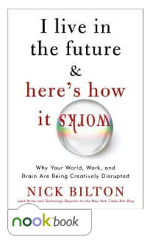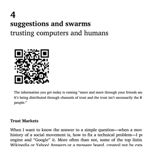 I just finished reading my first ebook on my new NookColor: Nick Bilton‘s I Live in the Future and Here’s How It Works. It was an interesting experience, done primarily on the Nook, but thanks to the B&N apps, I also could read it on my PC and on my Droid phone, which I did. I will definitely be reading more books this way.
I just finished reading my first ebook on my new NookColor: Nick Bilton‘s I Live in the Future and Here’s How It Works. It was an interesting experience, done primarily on the Nook, but thanks to the B&N apps, I also could read it on my PC and on my Droid phone, which I did. I will definitely be reading more books this way.
Bilton’s book continues themes surfaced by Shirky and others that I have discussed in this blog, but he had some interesting nuances. One of the fascinating glimpses of the not-too-distant future in his book was that every chapter had a QR code under the chapter title. Using my Droid, I could snap from the chapter code to supplemental websites that provided additional background information for the chapter as well as videos of Bilton discussing the chapter. I could easily visualize the future textbooks having similar functionality, with our students actually using their smartphones for learning!
with our students actually using their smartphones for learning!
After reading a book, I like to go back and thumb through it. Having it now on my PC makes this just as easy to do, and I found that areas I highlighted either on the Nook or on my Droid showed up highlighted on my PC … so the three screens were sync’ed. Bilton talks about the three screens in Chapter 8, where he discusses the concept of 1:2:10. You tend to hold your smartphone one foot from your eyes, look at a desktop or laptop screen two feet away, and watch your TV from about ten feet. Bilton suggests that in the future, we will engage with content seamlessly across all three screens, though designing content to do so raises interesting challenges. For instance, Bilton imagines a scenario where I could be watching this weekend’s Army-Navy game (GO NAVY!) on TV and have to leave at half-time for an engagement. Under his scenario, my phone would know that I was leaving my TV and begin automatically providing updates on my phone until I got to my destination and fired up my laptop, where the information would shift over seamlessly to that screen. I cannot automatically do this now…but Bilton suggests this will be the norm before too long.
In other words, my view of the Army-Navy game would be customized for me and delivered as an experience, not just content. This individualization and customization theme permeated the book.
One of the most intriguing concepts in this book was in Chapter 6. Bilton notes that when you take out your smartphone and click “locate me”, a map appears with you in the center. Maps and charts (maps used at sea) have been part of my life for years. Mercator came up with the projection used by most map makers over 400 years ago, but maps always were based on places and landmarks. You would go into a store and buy a map of Richmond VA or Nebraska or the subway system. You would never go in as Bilton suggests and ask, “Oh, excuse me, can I buy a map of me?”
Yet, when ever I use FourSquare on Facebook, that is precisely what appears, a map of me!
Bilton uses this image of being in the center as a metaphor for life today. Rather than getting news from mainstream sources, we now use Twitter and Google Reader to customize our news experience. For many of our students, their main source of news is the “news feed” from Facebook (an application correctly named from their perspective!). We listen to our own collections of songs on our iPods or customized channels on Pandora rather than using CD’s or radios. As Bilton describes it, digital will more and more mean “immediate” and “infinite” and “extremely personalized” in the digitally narcissistic world where the customer is always at the center of the map.
It should not be too great a leap to take this shift from content or subject base to personal base and visualize it in the classroom of the future. Our students are growing up in a world where they are always at the center of the map…everywhere except in the classroom. In listening to some of the frustrations expressed by my students, I hear of too many teachers continuing to try and keep this personalization out of teaching. A doctoral student last week defended her dissertation (and did a nice job), but her study of eighteen high school teachers who had been in a 1:1 laptop initiative for EIGHT YEARS found that 15 of the 18 continued to teach as they always had with no demonstration that they had integrated technology into their teaching. Sad but not surprising. My students want to change as well, but express concerns that too many administrators and fellow teachers continue to view digital media as simply new ways to do the same old things.
Outside the classroom, our students are experiencing a rich world centered around themselves. When they buy applications, they do not buy content, they buy experiences. Driving around town, they can use their phone now to locate local shops or restaurants on the fly..or with Foursquare, locate their friends. Some are now suggesting that the majority of our access to the internet will be via our smartphones, and when you couple access to information with yourself in the center of the map, all sorts of possibilities explode.
What if we took this concept to education? What would a school of me look like?
If the student was at the center of the learning process, then instruction would be personalized based on that student’s prior knowledge and abilities. Personal learning networks would be more the norm, and through networked learning, students would create their own knowledge base (and content). Students could access not only facts off the internet, but connect to others with similar interests and passions about the learning topic they are studying. I have used her before, but Wendy comes to mind when looking at a school of me.
One also gets a glimpse if one looks at the nominees for this year’s Edublog Awards. The nominees across the 23 categories are out on the cutting edge when it comes to using digital media for learning (and be sure to vote for this year’s winners).
What would it take to move schools towards a school of me? Leadership. Vision. Risk. Yet, could a “school of me” be an answer to the challenges facing education…particularly the challenges in which we seem to be falling behind much of the world. The Asian dominance in this year’s PISA test scores suggests that continuing to educate as we have is a prescription for further failure.
Bilton’s final chapter says “they’re not coming back.” He is talking about traditional consumers, traditional media, and traditional brands. Yet, while our students have evolved and continue to change, education has for the most part not changed. How can you worry about going back if you never left?
What are your thoughts? Can technology deliver a School of Me? Is it the right direction to take? I would be interested in your thoughts.


Not sure if my previous comment made it as I was having connectivity issues – and even still I wanted to come back and just high-five this piece. Not so much for the excellent writing, but the feeling that’s here and very disruptive in saying that “tech has changed, new learners have adapted, and things can’t go back as they were.” In my space, I’ve lived with such an ideal long enough now that there are aspects of learning, living, and computing that are painful if I have to go back (such as using a desktop/laptop vs a mobile for commenting) – and yet I realize that such living is only a part of the puzzle. Tech is part of the answer, behavior transformations (revaluing learning and living with one another) is the other part. How we can answer that might be in the tech, but is also in contextually relating to one another beyond the bits and bytes.
Britt, this is a great book report. You are still, as always , on the cutting edge. Bilton’s talk on PopTech is a recurring bit of media in my art classes.
http://www.poptech.org/popcasts/nick_bilton_smart_content
My first semester at Whitman was very enlightening. It’s a wonderful place and I finally have time to do my research. Next semester I will be co-facilitating a multi-disciplinary group on Computational thinking.
I only have 2 classes next semester, so there should be time to stay in touch.
Hello sir, I just read the first part of your blog and it was so in tune with what we have been blogging about in class lately.
I loved to hear about a real live application of the inter-connectedness of technology. You were able to read your book on the various devices.
That is the way technology will be in the classrooms of the future. It will cater to the inividual learning styles of its students. It is teachers like you (and hopefully some of us) that will be there to guide them.
Thanks
I really enjoy reading your post sir, and I have been thinking on getting myself an electronic reader, but with all the details you have mentioned in your blog, I am more attempted to do it and why not to say jump into what we have been talking about during this semester, as many of us have mentioned technology is here to stay so why not to start using it and learning by it. Next time I see that symbol you mentioned I will use my phone to find out what it takes me too.